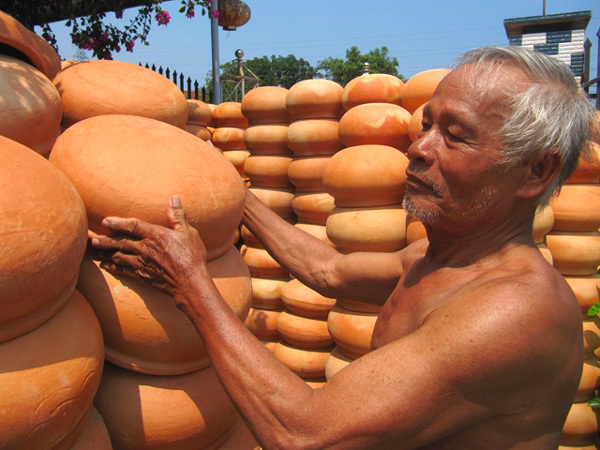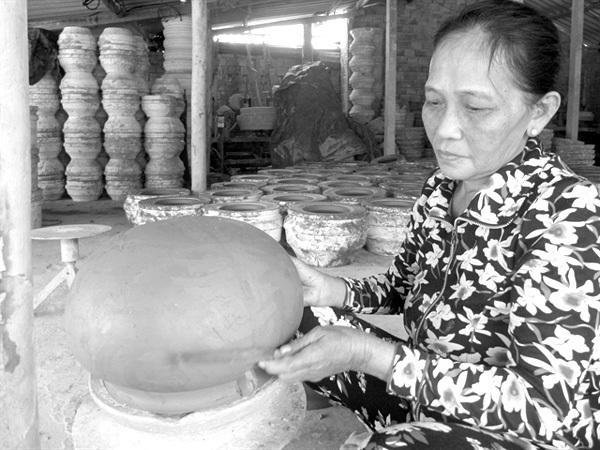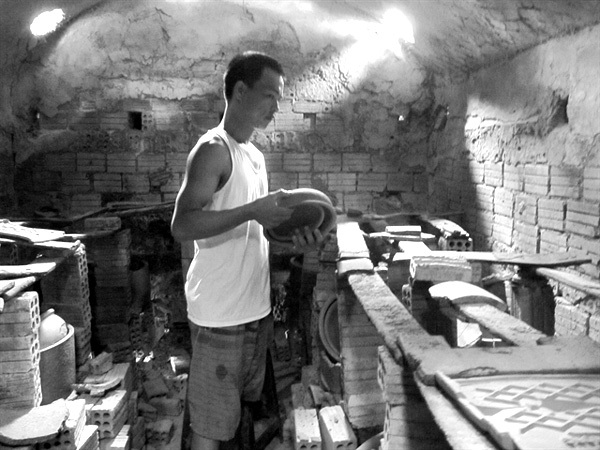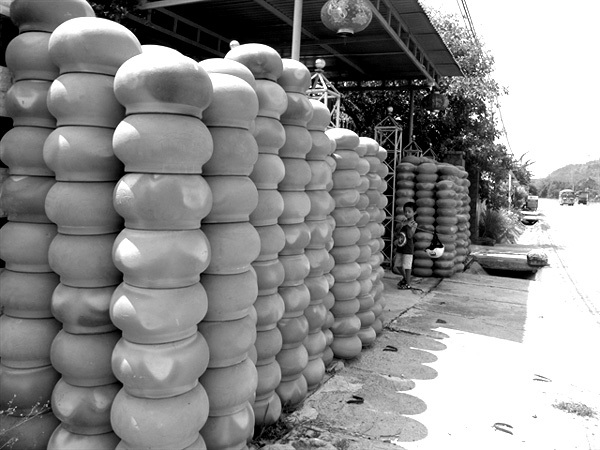Discovering Vietnam’s archaeological treasures
Quang Ngai hosts exhibition featuring treasures of ancient shipwrecks
A son of the soil returns to his craft
 |
| PILES OF HISTORY: Potter Nguyen Trung Thuat, 78, stacks finished products at his family-owned business in Pho Khanh Commune in Quang Ngai Province. VNS Photo Cong Thanh |
Earthenware potteries, once forgotten years ago in favour of plastic alternatives, has recently become popular again among rural restaurants.
What used to be a busy pottery hub, 60km south of Quang Ngai City, with 300 households producing earthenware in the late 1970s, now consists of 10 families and a dozen skilled potters.
 |
| CAREFUL CARVING: A woman trims a clay pot in Pho Khanh Commune. Several families in the commune still make their living from the old trade. |
The potters, now in their later years, are struggling to keep the trade alive as youngsters follow other trades looking for better money.
Kitchenware, including jars, bowls and pots, was the main products of the commune, with prices ranging from VND20,000 (nearly US$1) to VND40,000 ($1.7) per item. At least 10,000 pieces were sold each month at markets in the provinces of Binh Dinh, Quang Nam, Quang Ngai and Thua Thien-Hue.
Nguyen Tan Hop, 35, the owner of a pottery workshop in the commune, said the trade has provided a regular income for his family since his great-great-grandfather, and still creates jobs for some old potters in the commune who earn around VND200,000 ($8.7) per day.
 |
| PASSION FOR POTTERY: Nguyen Tan Hop, 35, owner of a pottery kiln in Pho Khanh Commune, removes terracotta pots from a kiln. Thousands of pottery products are made by the kiln each month for sale in the central region. VNS Photos Cong Thanh |
“I learned the trade from my maternal grandfather and mother. My mother was a skilled potter in the commune, but she retired due to old age. However, I have recovered the family trade in recent years as earthenware products started to become more popular again,” Hop said.
“Clay pots and firewood stoves, which were replaced by gas and electric ovens, have lured chefs as they provide a more natural aroma to the food,” he explained.
He said some restaurants in the city use clay pots to cook food in a unique style.
Old potters
Hop’s mother, Phan Thi Ha, 75, recalled that women with skilful hands were assigned to form wet clay on the potter's wheel into pots and dry them in the sunlight, while men did heavier jobs such as digging and kneading clay as well as placing the raw products in the kiln.
Ha said pottery was her childhood and helped the family get through difficult times, and the tradition was now being kept alive by her son.
“Women were masters of the wheel – where potteries are formed by their gentle hands,” she said.
 |
| READY FOR SALE: Finished pots and jars at a pottery workshop in Pho Khanh Commune on National Highway No 1. |
“Earthenware products were used by people in rural areas as water containers, cooking pots, jars and stoves, as peasants often cooked food with firewood, thatch and dry leaves,” she said.
The old woman said gas ovens are now commonplace, but rural communities still prefer the traditional way.
Hop said the Pho Khanh earthenware can be told apart from those of other villages as it does not use enamel.
“We mixed grey clay and yellow clay with an appropriate ratio before shaping it into pots on wooden wheels. The work must be done in the dry season, and production often ends before rain starts in late October,” Hop said.
“In speeding up the process for mass production, manual wheels were replaced by machines, and women would only trim wet clay after it is formed,” he said.
He said brick kilns at the family-owned pottery are used every week to produce thousands of items to order.
He said baking kilns take 12 to 13 uninterrupted hours at temperatures of over 1,000 degrees Celsius, creating unique colours for the Pho Khanh terracotta.
Hop’s father, Nguyen Trung Thuat, 78, said making clay was a hard job for men.
“We have to dig deep to find the best clay before drying it in the sun for days. We then mixed different clay (yellow and grey) with water. Smooth clay helps make fine products,” Thuat said.
He said he has retired from the trade to look after his grandchildren and help his son with odd jobs.
Le Thi Chuong, 59, from Vinh An Village, said she had been working at the pottery since the early 1990s.
“My family also make terracotta, but the trade could not compete against jobs offering higher incomes. Young people can earn more from masonry, fishing or mechanics, so pottery is the only option for old people,” she said.
“We could not make money from other jobs after rice farming, livestock feeding or pottery. Anyway, I'm almost addicted to the smell of clay since I was born and grew up in the village. I love touching clay at least once a day.”
Vinh An and Trung Son are two of the only villages in the commune that continue the trade.
Ancient culture
Archaeologist Doan Ngoc Khoi said today's pottery trade in Pho Khanh Commune was rooted in the Sa Huynh Culture (from 2,500 to 3,000 years ago).
He said communities of the Sa Huynh Culture had settled around An Khe Lake, and the trade emerged.
Pottery continued to be done by the Cham people and then the Viet (Vietnamese majority people).
“The craft in Pho Khanh Commune has progressed from that of the Sa Huynh and Cham people. Ancient potters used their hands to form items, not wooden wheels,” Khoi explained.
“Ancient people used a stone fragment to trim or smooth the surface of the clay before baking, while now Pho Khanh potters use a wooden knife,” he said.
 |
| PLAYFUL POTTERY: Children play with flower pots at a family workshop in Vinh An Village of Pho Khanh Commune. Youngsters are involved with the craft from an early age. VNS Photo Cong Thanh |
“Vietnamese potters today share the same skills as ancient craftsmen. The process has been accelerated with machinery,” he said.
Khoi said Sa Huynh and Cham people baked clay outdoors, but they did not use kilns with lower temperatures.
He said Sa Huynh and Cham potters mixed sand, rock and plants with wet clay – contrasting to how the terracotta of modern Pho Khanh potters is made.
“Pottery is part of the heritage of the Sa Huynh Culture. Many artefacts of the Sa Huynh Culture and Champa Kingdom are similar to modern potteries in colour and design, as well as the methods used to make them,” Khoi said.
The commune has undergone a facelift, with infrastructure booming along National Highway 1 and the Trans-Vietnam railway in the last couple of decades, while potters hold tight to their manual craft.
“Clay work is part of our lives. It brings happiness to the community. We hope the trade will continue and is taken up by the next generation, but there needs to be renovation and changes in production,” pottery artisan Chuong said. VNS
Cong Thanh
 Situated at the foot of Dau Mountain, many earthenware potters in Pho Khanh Commune in the southern central province of Quang Ngai still earn a living from the traditional trade despite rapid urbanisation.
Situated at the foot of Dau Mountain, many earthenware potters in Pho Khanh Commune in the southern central province of Quang Ngai still earn a living from the traditional trade despite rapid urbanisation.